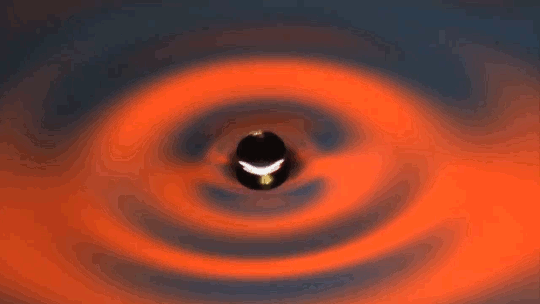Walking droplets – drops that bounce their way across a pool of the same liquid without coalescing – have fascinated researchers in recent years with their unusual behaviors, some of which mimic quantum phenomena. In a new experiment, researchers vibrate the pool at two frequencies simultaneously, which helps support much larger droplets, known as superwalkers. When the two driving frequencies are close to a harmonic match – like at 80 Hz and just under half that at 39.5 Hz – the droplets will walk, then come to a stop, and then begin walking again. (Image and research credit: R. Valani et al.; via APS Physics; submitted by Justin B and Kam-Yung Soh)
Tag: dual walkers

Pilot-Wave Hydrodynamics: Droplet Tunneling
This post is part of a collaborative series with FYP on pilot-wave hydrodynamics. Previous posts: 1) Introduction; 2) Chladni patterns; 3) Faraday instability; 4) Walking droplets; 5) Droplet lattices; 6) Quantum double-slit experiments; 7) Hydro single- and double-slit experiments; 8) Quantum tunneling
Quantum tunneling is a strange subatomic behavior that was first described to explain how alpha particles escape a nucleus during radioactive decay. Classically, a particle trapped in a well can only escape if its energy is sufficiently high, but in quantum mechanics, even a particle with lower-than-necessary energy can occasionally “tunnel” out.
To test whether hydrodynamic walkers can tunnel, researchers built corrals. In the central region, the pool on which the walker moves is relatively deep. Over the walls, the pool is much shallower. In this shallow area, the wave from the droplet’s bouncing decays quickly, creating a partially reflective barrier. For most collisions, the walker reflects off the barrier. Other times, apparently at random, a collision results in the walker crossing the wall and tunneling out of its well.
Over many experiments, researchers were able to construct a probabilistic view of walker tunneling. In quantum mechanics, a particle’s likelihood of tunneling out of a well depends on the particle’s energy and the well’s thickness. The analogs for a walker are velocity and barrier thickness. The thicker the barrier, the harder it is for a walker to tunnel through. Conversely, a faster walker has a higher probability of tunneling through a barrier of a given thickness. As the authors themselves observe:
“Although our experiment is foreign to the quantum world, the similarity of the observed behaviors is intriguing.” #
As we wrap up our series tomorrow, we’ll consider some of those similarities more deeply.
(Image credits: A. Eddi et al., sources)

Pilot-Wave Hydrodynamics: Slit Experiments
This post is part of a collaborative series with FYP on pilot-wave hydrodynamics. Previous entries: 1) Introduction; 2) Chladni patterns; 3) Faraday instability; 4) Walking droplets; 5) Droplet lattices; 6) Quantum double-slit experiments
In quantum mechanics, the single and double-slit experiments are foundational. They demonstrate that light and elementary particles like electrons have wave-like and particle-like properties, both of which are necessary to explain the behaviors observed. Similarly, a hydrodynamic walker consists of both a particle and a wave, so, perhaps unsurprisingly, researchers tested them in both single-slit and double-slit experiments.
When a walker passes through a single-slit (top row), it’s deflected in a seemingly random direction due to its waves interacting with the slit. But if you watch enough walkers traverse the slit, you can put together a statistical representation of where the walker will get deflected. Compare that with the results for a series of photons passing through a slit one-at-a-time, and you’ll see a remarkable match-up.
If you test the walker instead with two slits, the droplet can only pass through one slit, but its accompanying wave passes through both (bottom row). Let enough walkers through the system one-by-one, and they, like their photonic cousins, build up interference fringes that match the quantum experiment. Diffraction and interference are only a couple of the walkers’ tricks, however. In the next posts, we’ll take a look at another analog to quantum behavior: tunneling.
(Image and research credits: Couder et al., source, selected papers 1, 2; images courtesy of E. Fort)

Pilot-Wave Hydrodynamics: Walking Drops
This post is a collaborative series with FYP on pilot-wave hydrodynamics. Previous entries: 1) Introduction; 2) Chladni patterns; 3) Faraday instability
If you place a small droplet atop a vibrating pool, it will happily bounce like a kid on a trampoline. On the surface, this seems quite counterintuitive: why doesn’t the droplet coalesce with the pool? The answer: there’s a thin layer of air trapped between the droplet and the pool. If that air were squeezed out, the droplet would coalesce. But it takes a finite amount of time to drain that air layer away, even with the weight of the droplet bearing down on it. Before that drainage can happen, the vibration of the pool sends the droplet aloft again, refreshing the air layer beneath it. The droplet falls, gets caught on its air cushion, and then sent bouncing again before the air can squeeze out. If nothing disturbs the droplet, it can bounce almost indefinitely.

Droplets don’t always bounce in place, though. When forced with the right frequency and acceleration, a bouncing droplet can transition to walking. In this state, the droplet falls and strikes the pool such that it interacts with the ripple from its previous bounce. That sends the droplet aloft again but with a horizontal velocity component in addition to its vertical one. In this state, the droplet can wander about its container in a way that depends on its history or “memory” in the form of waves from its previous bounces. And this is where things start to get a bit weird – as in quantum weirdness – because now our walker consists of both a particle (droplet) and wave (ripples). The similarities between quantum behaviors and the walking droplets, the collective behavior of which is commonly referred to as “pilot-wave hydrodynamics,” are rather remarkable. In the next couple posts, we’ll take a look at some important quantum mechanical experiments and their hydrodynamic counterparts.
(Image credit: D. Harris et al., source)








